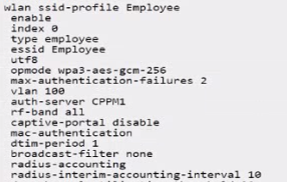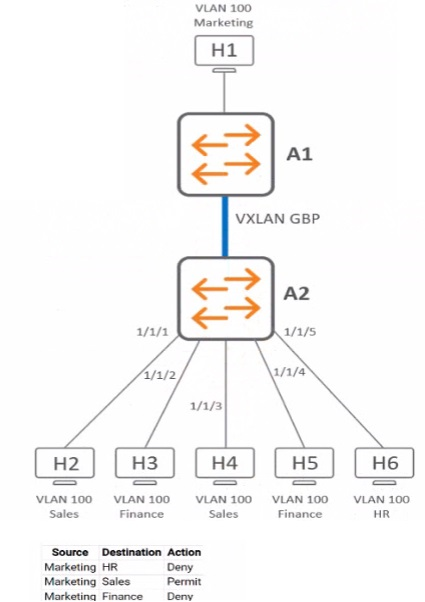Master HPE7-A07 Exam with Reliable Practice Questions
A customer is planning to add loT devices that connect wirelessly to the existing 802.1X SSlD. The customer will use ClearPass to authenticate the IoT devices by MAC address but other devices will still need to authenticate by only 802 1X
Exhibit.

The customer provided the current configuration and reported their non-loT 802. IX devices are no longer able to connect. Which configuration change can be made to fix the issue?
Correct : C
The existing configuration for the WLAN ssid-profile has enabled MAC authentication which, while suitable for IoT devices that may not support 802.1X, can interfere with the normal 802.1X authentication process for other devices. By removing the mac-authentication directive from the WLAN configuration, the non-IoT 802.1X devices should be able to connect without issues as the authentication process will not be disrupted by MAC authentication checks. This adjustment ensures that the WLAN ssid-profile is correctly aligned with the authentication requirements for both IoT and non-IoT devices within the network environment, conforming to the best practices for mixed-device WLAN configurations.
Start a Discussions
A customer's infrastructure is set up to use Doth primary and secondary gateway clusters on the SSID profile What is a valid reason for the AP to failover to the secondary gateway cluster?
Correct : A
In Aruba's infrastructure, the Access Points (APs) are configured with primary and secondary gateway clusters to ensure connectivity and resiliency. The APs will failover to the secondary gateway cluster if they are unable to reach the primary gateway cluster, even if the primary cluster is operational. This mechanism ensures that the APs maintain connectivity to the network infrastructure for continuous service delivery.
Start a Discussions
A customer has interfering devices that are seen over the air. They contact you and ask you to configure RAPIDS to help identify interfering and rogue APs. HPE Aruba Networking Central identifies a rogue AP and displays the connected switch port.
How can HPE Aruba Networking Central identify which switch port the AP is connected to?
Correct : D
HPE Aruba Networking Central can identify which switch port a rogue AP is connected to by using the switch's MAC address table. The MAC address table contains the associations between MAC addresses and the switch ports to which devices (including APs) are connected. When Aruba Central detects a rogue AP, it can look up the MAC address of the rogue AP in the switch's MAC address table to find the specific switch port it is connected to. This enables network administrators to quickly locate and address the rogue AP issue.
Start a Discussions
Exhibit.

What is me expected behavior for ARP traffic sent from H1?
Correct : C
In a VXLAN environment, unknown unicast traffic, such as ARP requests from H1, which does not have a specific destination MAC address learned by the switch A2, will be flooded out of all interfaces. This flooding behavior is necessary because A2 needs to ensure that the ARP request reaches its intended destination, which might be on any of the interfaces. It's a part of the standard behavior of switches to handle ARP traffic when the destination hardware address is unknown.
Start a Discussions
What is me recommended configuration to ensure link aggregation is consistent in a campus topology using VSX with two aggregation switches and downlinks to access switches?
Correct : C
When configuring Virtual Switching Extension (VSX) in a campus topology for link aggregation across two aggregation switches, it is important to synchronize Multi-Chassis Link Aggregation Group (MC-LAG) interfaces. The command 'vsx-sync mclag-interfaces' ensures that the state and configuration of MC-LAG interfaces are synchronized between the two VSX-linked switches, providing consistent link aggregation and preventing any loops or mismatched configurations that might occur if the interfaces were not in sync.
Start a Discussions